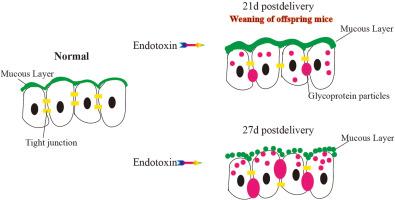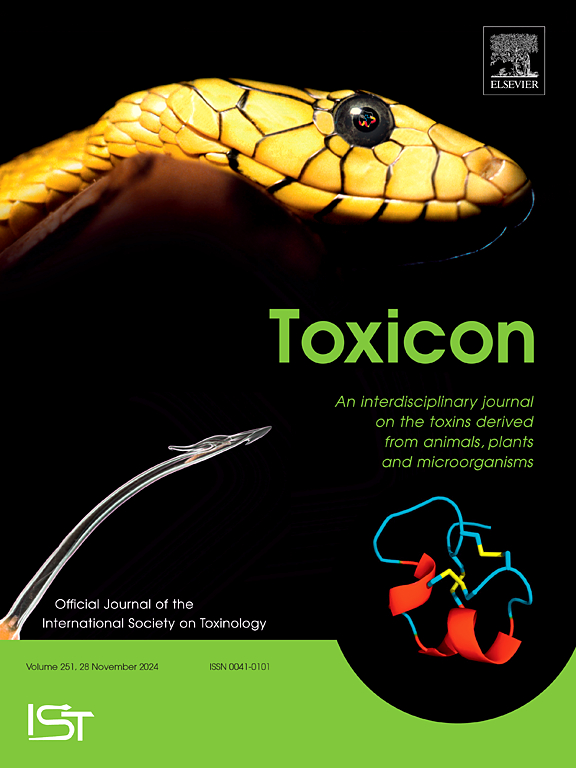Study repair function of mucin-2 on the tight junction protein of uterine epithelial cells under bacterial endotoxins
IF 2.6
4区 医学
Q2 PHARMACOLOGY & PHARMACY
引用次数: 0
Abstract
To analysis repair function of mucin-2(MUC2) and glycoprotein particles on the tight junction protein of uterus under bacterial endotoxins. In this experiment, we showed that the thicker mucus layer of the uterus is used to prevent the translocation of endotoxin at 21d postdelivery. When endotoxin acts on the uterus to thin its mucous layer, the cells in the lamina propria of the uterus secrete a large number of glycoprotein particles at 27d postdelivery. Due to a significantly decrease in the expression of glycosyltransferase, the glycoprotein particles are incompletely glycosylation MUC2, which can interact with the cell membrane and are released in large quantities in the form of exocytosis. These glycoprotein particles can significantly repair tight junction proteins in the inter-cellular space and significantly increase the expression of Claudin-1, JAM (Junction adhesion molecule-A), E-cadherin, ZO-1(Zonula occludens-1) and desmosome proteins after endotoxin treatment. The results of the present study show that endotoxins can thin the uterine mucus layer and accelerate the release of incompletely glycosylated MUC2 from lamina propria cells. In inter-cellular spaces, MUC2 can increase its expression levels and distribution area to repair the tight junction structure of cells with larger gaps. Further strengthening of the barrier prevents endotoxin translocation by repairing the tight junction structure of uterine epithelial cells.

研究细菌内毒素作用下粘蛋白-2对子宫上皮细胞紧密连接蛋白的修复功能
分析粘蛋白-2(MUC2)和糖蛋白颗粒在细菌内毒素作用下对子宫紧密连接蛋白的修复功能。本实验表明,在分娩后 21 天,较厚的子宫粘液层可用于阻止内毒素的转运。当内毒素作用于子宫使其粘液层变薄时,子宫固有层细胞会在分娩后 27 天分泌大量糖蛋白颗粒。由于糖基转移酶的表达明显减少,糖蛋白颗粒中的MUC2糖基化不完全,可与细胞膜相互作用,并以外渗的形式大量释放。这些糖蛋白颗粒能明显修复细胞间隙的紧密连接蛋白,经内毒素处理后,Claudin-1、JAM(连接粘附分子-A)、E-cadherin、ZO-1(Zonula occludens-1)和脱绒毛蛋白的表达明显增加。本研究结果表明,内毒素可使子宫粘液层变薄,加速固有层细胞释放未完全糖基化的 MUC2。在细胞间隙中,MUC2 可增加其表达水平和分布面积,以修复间隙较大的细胞的紧密连接结构。通过修复子宫上皮细胞的紧密连接结构,进一步加强屏障,防止内毒素转运。
本文章由计算机程序翻译,如有差异,请以英文原文为准。
求助全文
约1分钟内获得全文
求助全文
来源期刊

Toxicon
医学-毒理学
CiteScore
4.80
自引率
10.70%
发文量
358
审稿时长
68 days
期刊介绍:
Toxicon has an open access mirror Toxicon: X, sharing the same aims and scope, editorial team, submission system and rigorous peer review. An introductory offer Toxicon: X - full waiver of the Open Access fee.
Toxicon''s "aims and scope" are to publish:
-articles containing the results of original research on problems related to toxins derived from animals, plants and microorganisms
-papers on novel findings related to the chemical, pharmacological, toxicological, and immunological properties of natural toxins
-molecular biological studies of toxins and other genes from poisonous and venomous organisms that advance understanding of the role or function of toxins
-clinical observations on poisoning and envenoming where a new therapeutic principle has been proposed or a decidedly superior clinical result has been obtained.
-material on the use of toxins as tools in studying biological processes and material on subjects related to venom and antivenom problems.
-articles on the translational application of toxins, for example as drugs and insecticides
-epidemiological studies on envenoming or poisoning, so long as they highlight a previously unrecognised medical problem or provide insight into the prevention or medical treatment of envenoming or poisoning. Retrospective surveys of hospital records, especially those lacking species identification, will not be considered for publication. Properly designed prospective community-based surveys are strongly encouraged.
-articles describing well-known activities of venoms, such as antibacterial, anticancer, and analgesic activities of arachnid venoms, without any attempt to define the mechanism of action or purify the active component, will not be considered for publication in Toxicon.
-review articles on problems related to toxinology.
To encourage the exchange of ideas, sections of the journal may be devoted to Short Communications, Letters to the Editor and activities of the affiliated societies.
 求助内容:
求助内容: 应助结果提醒方式:
应助结果提醒方式:


